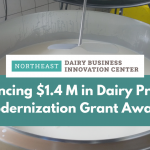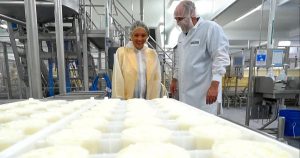
The Agriculture Department issued its Federal Order reform final decision last week outlining changes in U.S. dairy pricing. A producer referendum will be held in December or January after which a final rule will be published.
StoneX analyst Nate Donnay says there were only minor changes between the recommended decision released July 1 and the final decision. He said “It’s expected that all orders will vote to accept the new language, but there have been rumblings that the Upper-Midwest might be a close vote.” We should know the results somewhere between late January and mid-February, he said.
The implementation timeline will also be issued at that point, according to Donnay, but “From a risk management perspective, the timeline is the biggest unknown. The changes could start as soon as March pricing, or possibly delayed a few months. One thing we do know is that the implementation of changes to assumed component content will be delayed six months from the other changes.”
Speaking in the Nov. 18 Dairy Radio Now broadcast, StoneX broker Dave Kurzawski said USDA is raising the assumed costs of converting milk into bulk dairy products, often referred to as the make allowance, allowances that haven’t changed in over 10 years, despite the fact that costs have risen in that time.
Federal order minimum prices that manufacturers have to pay producers will be reduced, according to Kurzawski. Looking back on the past decade or so, had these new formulas been in place, the Class III price would have been about 16 cents lower while the Class IV would have been down about 47 cents.
It’s all about the relationship between finished dairy product prices and the prices that have to be paid for the milk, he said. It’s really a minimum price, a minimum wage for dairy farmers essentially, he explained.
In the early 2000s, dairy farmers often saw over order premiums such as $1.50 per hundredweight for example, which occurred due to the competitive nature of buying milk. Those premiums have since dwindled in pretty much every Federal order, he said, as the costs of producing dairy products have gone up.
“This change will lower the minimum prices and usher in a time when those over order premiums will start to go up and competition for milk will go up,” he said. Class I will come in a little higher, while Class II, III, and IV will be lower but we can still go to $12 milk and we can still go to $25 milk, it doesn’t change that dynamic, it just changes the relationship between the two, he concluded.
This is but a brief outline of some complicated formula changes. Best to talk with your local cooperative about how the changes will impact your operation.
Meanwhile, the Agriculture Department again raised its 2024 milk production forecast in its latest World Agriculture Supply and Demand Estimates report, based on the most recent Milk Production report and lower reported milk cow numbers for the third quarter of 2024 being more than offset by higher output per cow. The milk forecast for 2025 was unchanged.
2024 production and marketings were projected at 226 and 225 billion pounds respectively, up 200 million pounds on both from last month’s estimate. If realized, both would be down 400 million pounds or 0.2% from 2023.
2025 production and marketings were projected at 227.7 and 226.7 billion pounds respectively, unchanged on both from last month. If realized, both would be up 1.7 billion pounds or 0.75% from 2024.
Import forecasts for 2024 were unchanged, on both a fat basis and a skim-solids basis. The export forecast was unchanged on a fat basis but raised on a skim-solids basis, based on higher expected shipments of lactose. Imports for 2025 were unchanged on a skim-solids basis but raised on a fat basis on expected higher shipments of butter and cheese.
The export forecast on a fat basis was raised due to higher cheese and butterfat-containing products. Skim-solids exports were raised on higher whey-containing products and dry skim milk products, according to the WASDE.
The 2024 butter price forecast was reduced, as prices have continued to fall from the relatively high levels they maintained for much of the year through late-September. The cheese price was unchanged. Both nonfat dry milk (NDM) and whey price forecasts were raised due to strong demand for both products.
The butter price forecast for 2025 was lowered due to relatively higher inventories heading into the 2024 holiday season. The cheese price forecast was raised on higher prices and tight inventories in late 2024. Whey and NDM price forecasts were raised based on stronger domestic and international demand.

The 2024 Class III milk price forecast was unchanged at $19.05 per cwt. and compares to $17.02 in 2023 and $21.96 in 2022. The 2025 Class III average was estimated at $19.30, up 35 cents from a month ago.
The Class IV price forecast was lowered, with lower butter prices more than offsetting higher NDM, and was projected to average $20.75 in 2024, down a nickel from last month’s estimate, and compares to $19.12 in 2023 and $24.47 in 2022. The 2025 average was projected at $20.30, also down a nickel from last month.
This month’s U.S. corn outlook calls for lower production and ending stocks.
Corn production was forecast at 15.1 billion bushels, down 60 million or less than 1% from last month and down 1% from 2023. Yields are expected to average a record high 183.1 bushels per acre, down 0.7 bushel from the previous forecast, but up 5.8 bushels from last year. Area harvested was forecast at 82.7 million acres, unchanged from the previous forecast, but down 4% from a year ago. Ending stocks are down to 1.9 billion bushels and the season-average corn price was unchanged at $4.10 per bushel.
The soybean outlook includes lower production, exports, crush and ending stocks. Soybean production was forecast at 4.46 billion bushels, down 121 million or 3% from a month ago, on reduced yields, but up 7% from 2023. Yields are expected to average 51.7 bushels per acre, down 1.4 bushels from the previous forecast, but up 1.1 bushels from 2023. Area harvested was forecast at 86.3 million acres, unchanged from the previous forecast, but up 5% from 2023. Ending stocks were lowered 80 million bushels to 470 million. The season-average soybean price forecast was unchanged at $10.80 per bushel, with soybean meal unchanged at $320 per short ton.
The U.S. corn harvest was 95% completed, as of the week ending November 10, up from 91% the previous week, 9% ahead of a year ago, and 11% ahead of the five-year average. Soybeans are 96% completed, up from 94% the previous week, 2% ahead of a year ago, and 5% ahead of the five-year average.
There was encouraging news in the USDA’s latest Dairy Supply and Utilization report. Total cheese disappearance was up 0.7% and maintained year-on-year growth for the seventh consecutive month due to solid “other cheese” use, according to HighGround Dairy (HGD). Domestic use was up 0.3% while exports were up 6.8%. Exports are up 19.5% year to date and, through September, were record high.
Butter use was up 10.2%, up 9.9% domestically, while exports were up 21.7%. HGD says this marked a new record high for the month of September at 196.2 million pounds.
Nonfat dry milk (NDM) and skim milk powder (SMP) utilization remained below prior year levels, down 5.2%, but continued to rise month-to-month. Domestic consumption was down 41.4%, as September posted the lowest usage for the month on record, says HGD, with data back to 2011. International demand was up 15.6%, and is supporting the higher CME prices, according to HGD.
Dry whey use was up 2.6%, despite domestic demand being down 34.1% and down for the fourth month in a row. HGD says this was the smallest value for the month since November 2022. Exports were up 9.2% from a year ago.
In other trade news, the Global Dairy Trade Pulse auction Tuesday featured 4.96 million pounds of product sold, up from 4.8 million in the last Pulse.
HGD says 100% of what was offered was sold. 8.6 million more regular whole milk powder and 2.4 million less of instant whole milk powder was sold versus the last Pulse. 2.2 million pounds or 100% of the total offered was sold. Prices crept higher as well.
Checking LaSelle Street, CME cheese prices headed lower for the fourth week in a row. The cheddar blocks fell to $1.6575 per pound Thursday, lowest since April 18, but they closed the third Friday of November at $1.6925, still 2.75 cents lower on the week, but 9.25 cents above a year ago.
The barrels rolled to $1.6725 Thursday, lowest since April 19, but saw their Friday close at $1.6850, 8.25 cents lower on the week, but 12.50 cents above a year ago. There were 13 sales of block on the week at the CME and 5 of barrel.
StoneX Nov. 11 Early Morning Update stated that holiday cheese demand “doesn’t seem to be so joyful,” and said that new plant capacity is coming on line now and into 2025 and buyers may be holding off buying, working down inventories while waiting for the forthcoming new supply. But U.S. prices are now more competitive globally and domestic buyers may have some competition.
The Nov. 11 Daily Dairy Report warned, “By the middle of next year, expansions to U.S. cheese processing are expected to boost cheese output by nearly 20 million pounds per day. Assuming steady demand, this new capacity is large enough to lift cheese stocks to prior-year volumes with less than one week’s output. When all three expansions are running full throttle, it won’t take long to shift from today’s relatively tight supply situation to a burdensome surplus.”
Dairy Market News (DMN) reports that cheese demand is mixed, according to Midwest contacts, but more are on the strong side. Pizza cheesemakers say orders are robust, while others say customers are hesitant with market prices less than stable. Food service sales are reportedly quieter. Plant downtime continues to be reported, although not at the impactful levels it was in the early weeks of fall. Production is seasonally active. Milk availability varies, but generally balanced to somewhat tight. Some contacts believe Thanksgiving related plant downtime may not offer relief by way of affordable milk loads, but others are already seeing growth in milk availability, according to DMN.
Cheese production is mixed in the West. Milk is comparatively tighter in the southwest part of the region but adequate for production needs. Contractual demand is steady while foodservice is steady or somewhat weaker, and steady to somewhat stronger from retail. Domestic prices remain competitive internationally, which is contributing to more robust export demand, particularly with our closer southern neighbors, says DMN.
CME butter fell to $2.5975 per pound Tuesday, lowest price since Jan. 24. It closed Friday at $2.63, down 2 cents on the week but 14 cents above a year ago. There were 15 sales reported on the week.
Central butter demand has been “unaligned with typical seasonal patterns,” says DMN. “Market bears early in the fall season created some customer hesitation.”
Prior to the bearish market movements in September, contacts had been relaying that food service demand had been slower during the second half of 2024. Retail demand has been steady, or steadier, as the holiday season approaches. Cream availability has been robust. Some loads over the weekend were reported at flat multiples, with contacts saying they are turning cream away regularly.
Butter output is mixed in the West. A few manufacturers have begun lengthy churn maintenance which will decrease production for a good part of November and December. Some manufacturers are already heavily working through cream volumes. Butter stocks are in good shape for Thanksgiving demand and churns are working to build stocks for Christmas. Domestic butter demand is steady to lighter for retail and food service. Export demand is steady, according to DMN.
Grade A nonfat dry milk made it to $1.4050 per pound Thursday, highest CME price since Nov. 22, 2022, but it closed Friday at $1.40, up 1.25 cents on the week and 20.75 cents above a year ago, with 39 sales reported for the week.
Dry whey saw its Friday finish at 65.50 cents per pound, 2.50 cents higher, highest since March 31, 2022, and 24.50 cents above a year ago. There were 7 sales for the week.
Dairy cow slaughter continues to lag year ago numbers. The week ending Nov.2 saw 48,300 head go to slaughter, down 1,900 from the previous week, and 7,500 or 13.4% from a year ago. Year to date, 2,303,300 head have been culled, down 353,300 or 13.3% from a year ago.
Farm level milk output varies across the country, according to DMN weekly update. Volumes in the Northeast have been steady in recent weeks, but weather conditions have limited milk production growth in the southern parts of the East region. Stable milk production is supported by mild weather over the Central region. Recent rains in the Upper Midwest have slowed field work, but corn and soybean harvests are ahead of previous years’ rates.
Western milk producers are seeing stronger production week to week. Class I demand is still strong across the country, well into the school year. Class III milk demand is strong and processors are pointing to snug supplies as a result. Cheesemakers are paying between 50 cents-over to $3-over Class III for milk. Cream spot loads are highly available across the country. Some butter producers are turning away loads in efforts to not overbuild inventories.
Lee Mielke is a graduate of Brown Institute in Minneapolis, Minnesota. He’s formerly the voice of the radio show “DairyLine” and his column appears in agricultural papers across the U.S. Contact him at lkmielke@juno.com.
You can now read the most important #news on #eDairyNews #Whatsapp channels!!!
🇺🇸 eDairy News INGLÊS: https://whatsapp.com/channel/0029VaKsjzGDTkJyIN6hcP1K
























